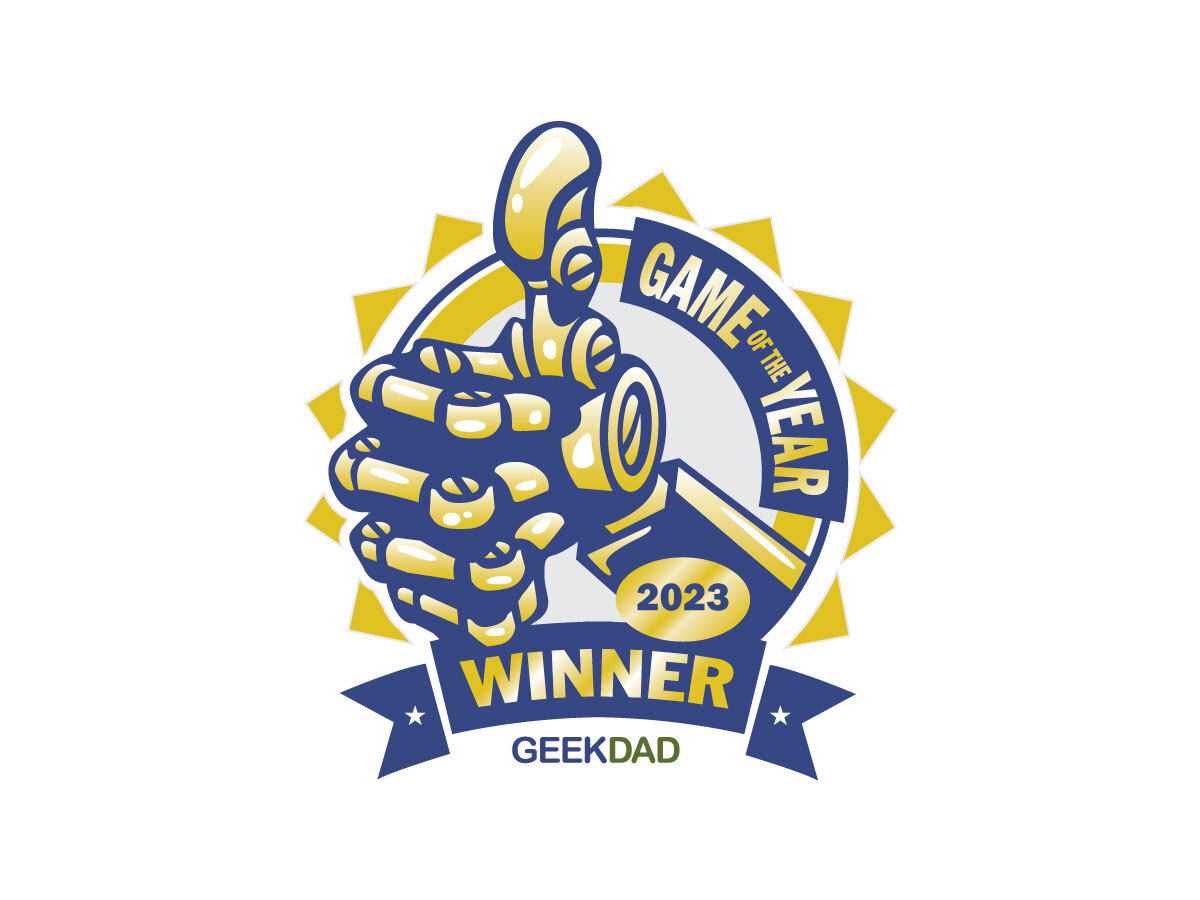Drivers sit in their vehicles which have been designed for only one thing–driving fast with as much control as possible. As they rev their engines, their minds are focused on their starting position and the first corner. Can they pass some of the cars ahead of them and get onto the racing line before that corner. Then the green flag is waved and the race is on. The drivers keep their accelerator pedal pushed all the way down to the metal and the only flag they want to see is the checkered one as they are the first to cross the finish line. Players can experience the speed and challenges of auto racing from the comfort of their gaming table with Heat: Pedal to the Metal.
What Is Heat: Pedal to the Metal?
Heat: Pedal to the Metal is a racing game featuring hand management for 1-6 players, ages 10 and up, and takes about 60 minutes to play. During the game, players play cards to move their racecar around one of four different tracks while also watching their speed around tight turns as well as their heat so their car does not spinout. It’s currently available from your FLGS as well as Amazon, with a suggested retail price of $75 for a copy of the game. Heat: Pedal to the Metal was designed by Asger Harding Granerud and Daniel Skjold Pedersen and published by Days of Wonders, with illustrations by Vincent Dutrait.
Heat: Pedal to the Metal Components
Here is what you get in the box:
- 2 giant double-sided boards (4 tracks)
- 4 track cards
- 6 race cars and matching gear pawns
- 6 player mats
- 72 speed cards
- 48 heat cards
- 37 stress cards
- 114 upgrade cards
- 35 sponsorship cards
- 10 legend cards
- 10 event cards
- 1 legends mat
- 1 championship mat
- 6 weather tokens
- 12 road condition tokens
- 2 press corner standees
- 1 scorepad
- 2 rule booklets
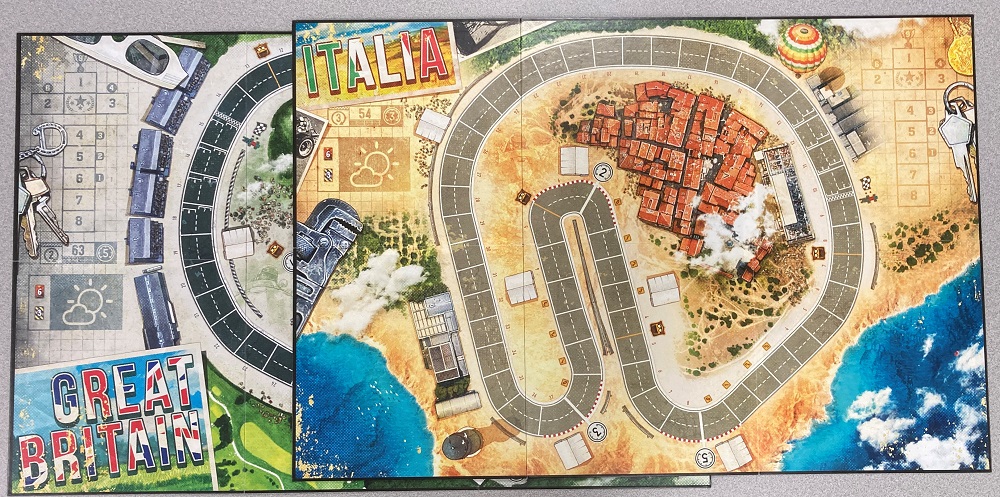
These two boards are double-sided and provide four different tracks for racing. They include USA, France, Great Britain, and Italy. For the first game, it is recommended to play the USA track.
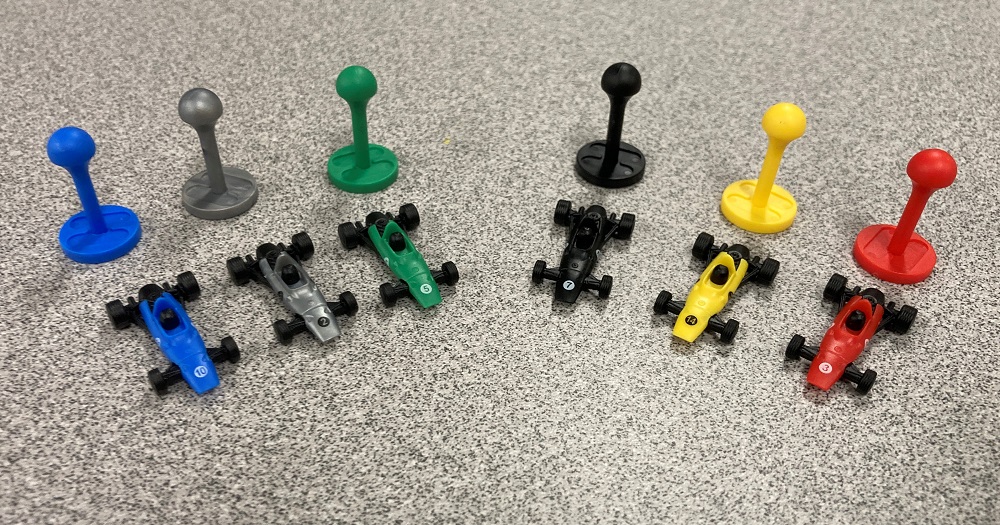
Each player gets a miniature racecar as well as a gear pawn in the matching color. There are enough racecars for six players.
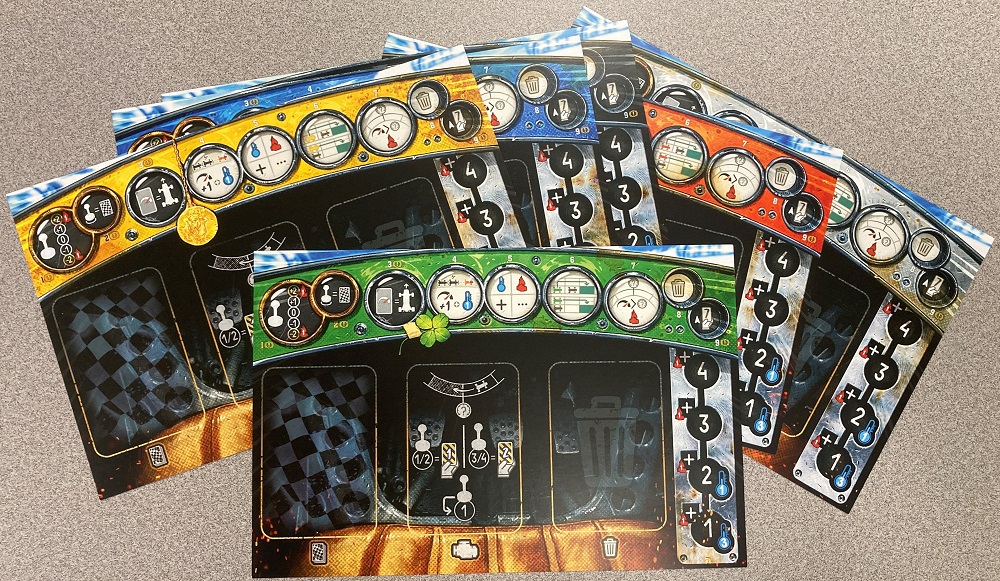
The six player mats match the colors of the cars. Across the top of the mat, the gauges represent the nine steps players may take during a round. There are three spots in the middle. The left slot is for the player’s draw deck. The engine in the middle spot is where you place your heat cards at the start, and the right spot is for discards. The gear pawn is placed along the right side to show which gear the car is in for the turn.

Speed cards have a speed dial across the top and have a number from 1-4 on them. they are played during a round to show how many spaces a racecar can move. For the basic game, there are also starting upgrade cards in the draw deck which have speed values of 0 or 5.

Stress cards provide an element of chance during a round and represent the stress the driver is under. Heat cards take up space in your hand and represent how hard you are pushing your racecar. It is important to manage your heat and cooldown if you have too many in your deck.
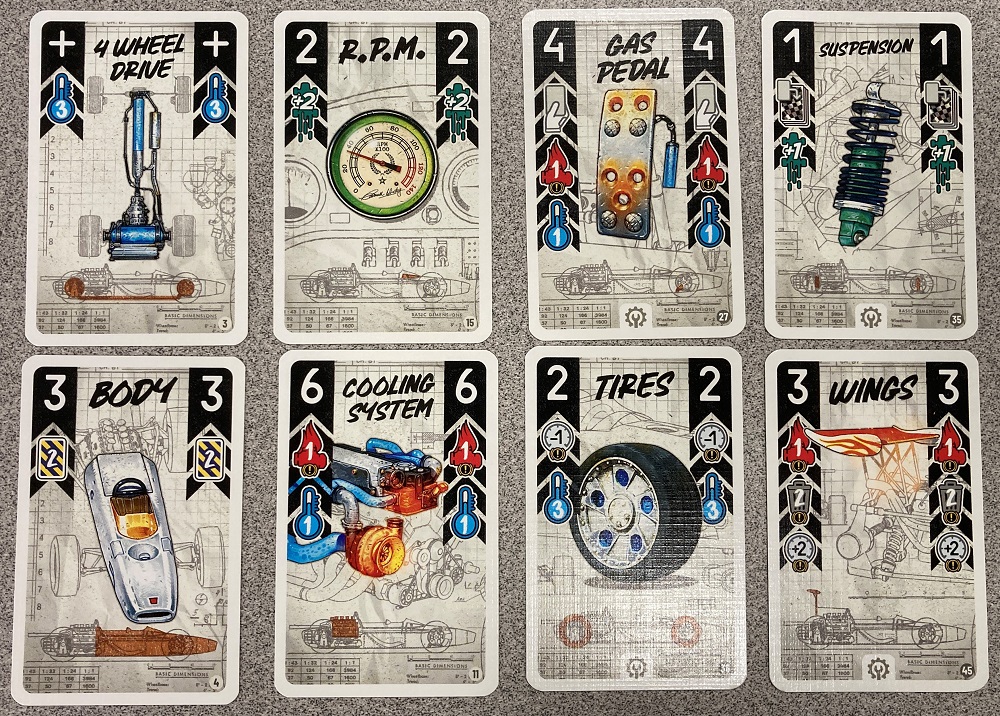
The Garage Module lets players customize their cars with 3 upgrade cards which are used instead of the 3 starting upgrade cards from the basic game. Players draft them at the start of the race. Upgrade cards can have speed values or other icons that allow you to take various actions during a round. The module includes 34 basic upgrade cards and 62 advanced upgrade cards. The advanced cards often provide more than one effect and are suggested for more experienced players who have a better understanding of the game mechanics. All of the icons on some of these cards can be confusing at first. However, just look at each icon and apply them individually. In the example above, the 4-wheel drive upgrade acts like a stress card and also provides 3 cooldown. The wings provide 3 speed, but you need to take a heat card, discard two cards from the top of your draw deck, and then increase the speed limit of a turn by 2.

The Legends module uses the legends mat and ten legends cards. It provides automated drivers you can compete against in solo mode or in multiplayer games as additional drivers. The legend cards act as an AI for these drivers and are drawn for each legend every turn to direct how they will move for the current round.

The Weather and Road Conditions module uses the weather tokens and road conditions tokens. This module modifies the track. A weather token is drawn before players customize their cars and the effects apply to the car setup as well as during the race. Road condition tokens are placed at each corner and affect either the corner or the sector of track from that corner to the next corner.
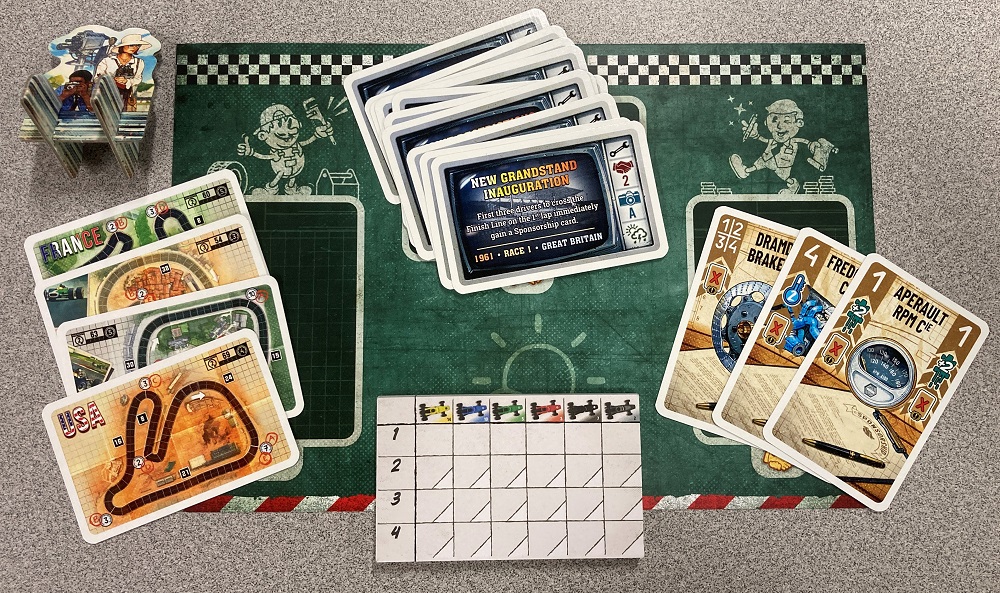
The Championship System uses the championship mat along with sponsor cards, track cards, event cards, the press corner standees, and the scorepad. These let you play three different seasons each with 3 or 4 races. Players can also use the event cards to create their own 4 race season.
How to Play Heat: Pedal to the Metal
You can download a copy of the rulebook here. For this section, we will be looking at playing a basic game without any of the advanced modules.
The Goal
The goal of the game is to complete the required number of laps and cross the finish line first.
Setup
Start off by selecting which track you will be racing on and then set that board in the middle of the table. Each player then picks a color and takes the matching racecar, player mat, gear pawn, and 12 speed cards as well as 3 starting upgrade cards. Next check the board to see how many heat and stress cards each player must add to their car. With their player mats in front of them, players then shuffle their speed cards, upgrade cards, and stress cards together to form their draw deck and place them facedown on the let spot on the mat. The heat cards are placed in the center spot while the spot on the right is for a discard pile. Place the remaining stress cards faceup in a pile near the board. Now randomly place the race cars on the starting grid filling spots in ascending order. This determines the player order for the first turn. Finally, players each draw seven cards from their draw pile to form their hand. You are now ready to play the game.

Gameplay
The game is played in a number of rounds, during which each player completes a number of steps. There are a total of nine steps. Steps 1, 2, 3, and 9 are required while the other five depend on the situation. The first two steps are completed by all players at the same time and then the remaining steps are taken in turn order. Let’s take a look at each of the steps.
1. Shift Gears
During this first step, players can change which gear their car is in. All cars start in first gear and they go up to fourth gear. The gear represents how many cards that player must play during the round. A player can move the gear token up or down one gear without any cost. They may choose to increase or decrease by two gears, but will gain one heat. Take one heat card from the pile on the player mat and place it in the discard pile.
2. Play Cards
Once players have set their gears, they then select which cards from their hand they will play. They must play the same number of cards as which gear their car is in. These cards are placed face down in front of each player. The remainder of the steps are completed by one player, then the next player completes all the steps and so forth. Note that you cannot play heat cards that are in your hand. If you have too many heat cards in your hand so that you cannot play enough cards to match your gear, do not move your car this turn, set the gear into first, and discard all the cards in your play area and skip straight to the last step, Replenish Your Hand.
3. Reveal and Move
The player whose car is in front and closest to the raceline goes first. For this step, they reveal the cards they have played and add up all the values to determine their speed. If a stress card is played, the player draws cards from their hand until they get a speed card. These have a number from 1 to 4 on them. This speed card is placed on top of the stress card and its value is added to the total. The player then moves their card forward a number of spaces equal to their speed. If the space is open, they then place their card in the spot closest to the raceline. If both spots on a space where you wound end your move already have cars on them, then you are blocked and must stop in the previous space. You can move through cars, but you can’t end in the same space where there are already two cars.

4. Adrenaline
This step only applies to the car that moves last, or in the case of 5-6 player games, the last two cars. These players can gain one extra speed as well as one extra cooldown. Both of these are used during the React step. Adrenaline gives an advantage who are behind and helps them catch up and get back into the race.
5. React
Players can boost as well as cooldown during this step based on symbols on their cards, their current gear, and from the Adrenaline step. When a player decides to boost, they take one heat card from the pile and place it in their discard pile. They then flip the top card of their draw deck until they draw a speed card (1-4). Other cards are put in the discard pile. The speed card is placed with the other cards played this turn and the car is moved that many more spaces along the track. Players can also perform a cooldown. They can get one from Adrenaline or from their current gear. For each cooldown, the player can take a heat card from their hand and place it back into the engine (center spot on the mat). This not only gets heat cards out of your deck, but allows you to use them again.
6. Slipstream
If a car ends up behind or next to another car at the end of their move, the driving player may move their car an additional two spaces. Slipstreaming does not increase your speed for the turn. It just lets you move your car a couple spaces.
7. Check Corner
When a player’s car cross through a corner during the round, they must do this step. Compare your total speed (including and speed gained by boosting) to the speed limit for the corner. If it is equal to or less than the speed limit, then nothing happens. However, if it is greater, subtract the total speed from the speed limit and then take heat cards from the engine and place them in your discard pile. If you do not have enough heat cards to pay price, your car spins out. Take all the heat that is available and move your car to the first available space before the corner that causes the spinout. Take 1 extra stress card from the pile by the board if you are in first or second gear (or two stress cards for third or fourth gear) and place them into your discard pile. Finally move your gear pawn to first gear.
8. Discard
Players may discard as many cards as they want from their hand. You cannot discard stress or heat cards or any cards that have a no discard symbol on them. This step is optional.
9. Replenish Hand
This is a required step. The player first takes all of the cards they played this round and place them into their discard pile. They then draw cards into their hand until they have seven cards. Now the next player completes steps 3-9. Once all players have taken their turn for the round, the next round begins. The first player is the one whose car is now in the lead.
Game End
You win the race by being the first player to cross the finish line after the required number of laps. If more than one car cross the finish line during the same round, then the one farthest ahead is the winner. You keep moving your car its full speed even after crossing the finish line. There is no slipstreaming after the finish line and you cannot slipstream across the finish line either. You do not need to check corners for any corner passed after the finish line. At the end of the round, remove the cars that finished and place them on the hall of fame track on the board. Continue playing until all cars have crossed the finish line.
Heat: Pedal to the Metal is our 2023 Game of the Year!
Why You Should Play Heat: Pedal to the Metal
When I first opened the box of Heat: Pedal to the Metal and delved through its contents, I was already impressed by the look and quality of the components. The game is set in the 1960s and the beautiful artwork has the feel of that time period. The racecars also look great. Plus the box comes with a plastic game tray for keeping all of the components organized. There are even spots for each of the cars and the gear pawns. I noticed that there is room for eight cars and eight pawns. Might there be an upcoming expansion? There are two rulebooks: one has the rules for the basic game while the other is for advanced games featuring the various modules I mentioned earlier. New players can use the first rulebook to set up the game and get playing right away. Then once they have had a few races under their belt, they can begin adding modules.
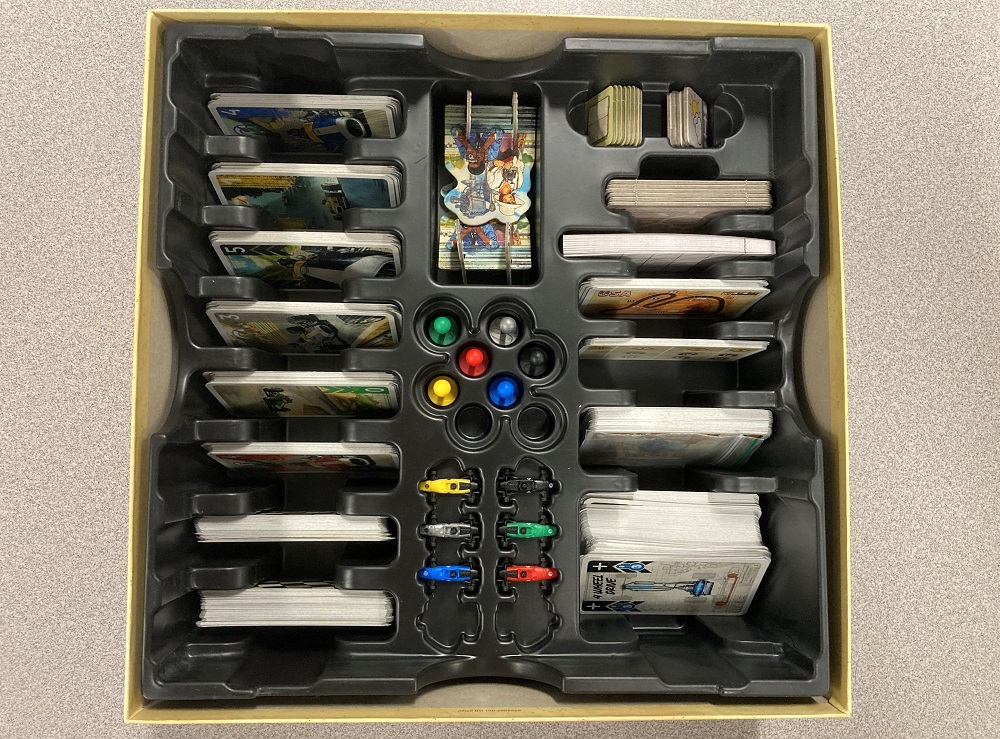
The rules for Heat: Pedal to the Metal are fairly straightforward. Everyone completes the first two steps at the same time, and then starting with the leading car, players complete the remaining steps of their turns. I really like how the designers used the player mats, which look like you are sitting inside a race car, to help remind players of the steps. Each step has its own gauge at the top of the mat with symbols showing what a player may do during that step and when it applies. So despite there being 9 steps per player’s turn, once you have played through a couple rounds and understand the steps, the playmat keeps everyone on track. After reading through the rules I was able to teach six teenagers from a high school tabletop game club the rules and they were playing and having a great time with little support from me after after a few rounds.
The basic rules are enough to make Heat: Pedal to the Metal a good game. They will keep players thrilled for several games, especially since there are four different tracks on which you can race. However, the included modules take a good game and make it great. The four modules can be added to the game individually as well as combined together. I would recommend playing each module at least once by itself to learn how it affects gameplay before combining them. The Legends module allows you to play the game solo and it works very well. Plus, if you don’t have four players, you can use this module to fill out the ranks so you can have more cars in the race. This is important since four or more cars in the race provides a lot more interaction between cars such as slipstreaming. The Garage module adds upgrade cards to the game. At the start of the race, players use a drafting mechanic to select three upgrade cards which replace the starter upgrades from the basic game. The basic upgrade cards for this module are easy to understand. However, some of the advanced upgrade cards had several icons that can be confusing to new players. That is why is is best to hold off on those until everyone is familiar with the game and the icons. I like how the Garage module can affect how you play a race as you try to maximize the advantages they give you. The Weather and Road Conditions module adds some randomness to the tracks. For example, if it is snowing, each player gets an additional cooldown each round, but they also start with one less heat card. Also each sector or corner of the track can have different conditions that affect the cars as they race through those areas. Finally, the Championship Series uses the other modules as well as adds sponsorship cards which act as upgrade cards you can only use one time. Players score points depending on their finish position in each race and then win the series if they have the highest total number of points at the end. Since players will be adding upgrades to their deck, the game tray has slots for each players draw decks so you can keep them separate if you are not playing all of the races in one sitting. The modules are a great addition to the game. It makes it seem like you are getting an expansion for the game that is already included in the box.
I really have a lot of fun playing Heat: Pedal to the Metal. The rules work well and are smooth. Though there are 9 steps, there are many rounds when you will not use all of the steps since they do not apply. I also like the Adrenaline step since it gives players in last place a chance to catch up. Slipstreaming does the same thing. The game has a great risk vs. reward system built into it using heat. You can rush through a corner above the speed limit as long as you can pay the heat. However, those heat cards start filling up your deck and your hand, limiting the number of cards you can play. Plus, you will need to cool down some in order to get those heat cards out of your hand and back into your engine so you can continue to speed around those corners. Spinning out because you could not pay the heat around a corner basically brings your car to a halt. However, you are not out of the race. You do gain a stress card as well and those can be stressful when you have to play them, especially if your engine is low or out of heat cards and you are headed into a corner since you have to use the next speed card you draw for the stress card. Yet, if your draw deck is getting low, you might have an idea of what is left since the rest of the speed cards are either in your hand or the discard pile. All put together, the balanced rules do a great job of keeping the race close to the very end and everyone engaged. In addition to all of the reasons I am impressed with this game as mentioned previously, I enjoy the strategy involved. You know what cards are in your hand before you choose a gear to determine how many cards you will play. With the exception of stress cards, you know how far your racecar will move that turn. Even when playing stress cards, you know that each will result in 1-4 speed, so you can even take that into account.
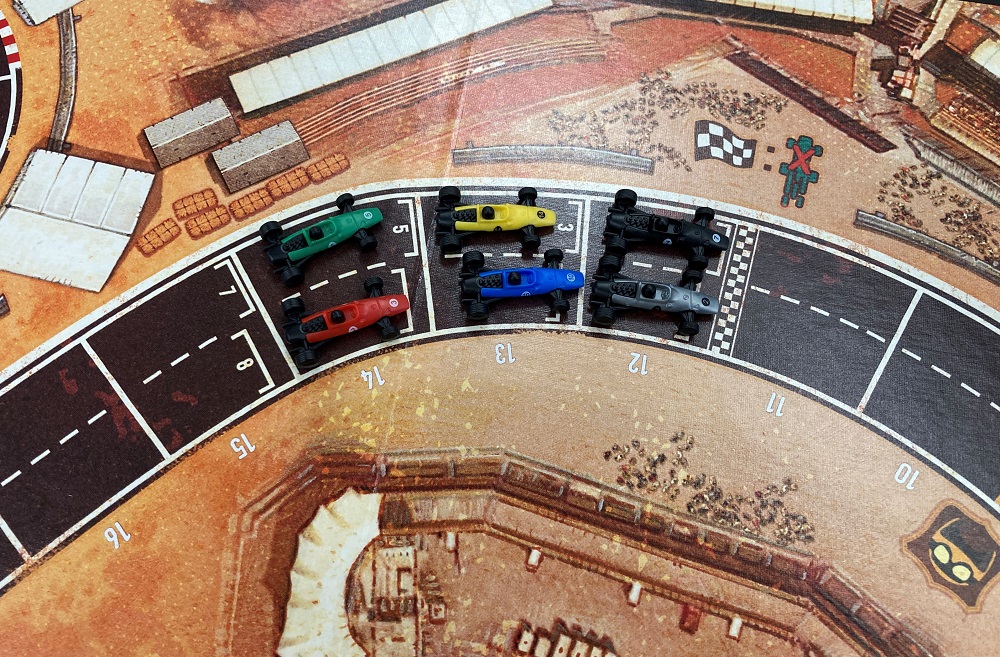
I have always been impressed with games published by Days of Wonder. They are fun games with wide appeal and rules that can be deep but also easy to learn. My family has played and enjoyed many of their games. The designers and artist are all veterans with several well-received titles to their name. Even with the track record of this great combination, Heat: Pedal to the Metal excels on its own merits. Of the racing games I have played, this is my current favorite and with the different tracks and modules, this game can hit the table regularly without becoming old. Furthermore, whether playing it solo or with six players, in my experience, everyone has had a good time and been excited right up to the checkered flag. For these many reasons, I am pleased to give Heat: Pedal to the Metal the GeekDad Approved seal. Whether playing with a family, a game group, of even by yourself. I highly recommend this game.
For more information, visit the Heat: Pedal to the Metal page!
Click here to see all our tabletop game reviews.
![]() To subscribe to GeekDad’s tabletop gaming coverage, please copy this link and add it to your RSS reader.
To subscribe to GeekDad’s tabletop gaming coverage, please copy this link and add it to your RSS reader.
Disclosure: GeekDad received a copy of this game for review purposes.

